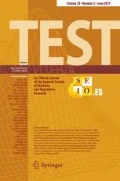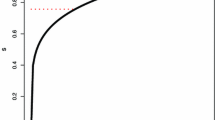Summary
A recursive procedure for temporally disaggregating a time series is proposed. In practice, it is superior to standard non-recursive procedures in several ways: (i) previously disaggregated data need not be modified, (ii) calculations become simpler and (iii) data storage requirements are minimized. The suggested procedure yields Best Linear Unbiased Estimates, given the historical record of previously disaggregated figures, concurrent data in the form of a preliminary series and an aggregated value for the current period. A test statistic is derived for validating the numerical results obtained in practice.
Similar content being viewed by others
References
Al-Osh, M. (1989). A dynamic linear model approach for disaggregating time series data.J. Forecasting 8, 85–96.
Chow, G. C. and Lin, A. (1971). Best Linear Unbiased Interpolation, Distribution and Extrapolation of Time Series by Related Series.Rev. Econ. Statist. 53, 372–375.
Cohen, K. J., Müller, W. and Padberg, M. W. (1971). Autoregressive approaches to disaggregation of time series data.Appl. Statist. 20, 119–129.
de Alba, E. (1988). Disaggregation and forecasting, a Bayesian analysis.J. Bus. Econ. Statist. 6, 197–206.
Denton, F. T. (1971). Adjustment of monthly or quarterly series to annual totals: an approach based on quadratic minimization.J. Amer. Statist. Assoc. 66, 99–102.
Friedman, M. (1962). The interpolation of time series by related series.J. Amer. Statist. Assoc. 57, 729–757.
Guerrero, V. M. (1990). Temporal disaggregation of time series: an ARIMA-based approach.Int. Stat. Rev. 58, 29–46.
Harvey, A. C. (1981).Time Series Models. Oxford: Halsted.
Harvey, A. C. (1989).Forecasting, Structural Time Series Models and the Kalman Filter, Cambridge: University Press.
Harvey, A. C. and Pierse, R. G. (1984). Estimating missing observations in time series.J. Amer. Statist. Assoc. 79, 125–131.
Hillmer, S. O. and Trabelsi, A. (1987). Benchmarking of economic time series.J. Amer. Statist. Assoc. 82, 1064–1071.
Nijman, T. E. and Palm, F. C. (1986). The construction and use of approximations for missing quarterly observations: a model-based approach.J. Bus. Econ. Statis. 4, 47–58.
Stram, D. O. and Wei, W. W. S. (1986). Temporal aggregation in the ARIMA process.J. Time Series Anal. 7, 279–292.
Trabelsi, A. and Hillmer, S. C. (1990). Bench-marking time series with reliable benchmarks.Appl. Statist. 39, 367–379.
Wei, W. W. S. (1990).Time Series Analysis. Univariate and multivariate Methods. Reading, MA: Addison-Wesley.
Wei, W. W. S. and Stram, D. O. (1990). Disaggregation of time series models.J. Roy. Statist. Soc. B 52, 453–467.
Author information
Authors and Affiliations
Rights and permissions
About this article
Cite this article
Guerrero, V.M., Martínez, J. A recursive ARIMA-based procedure for disaggregating a time series variable using concurrent data. Test 4, 359–376 (1995). https://doi.org/10.1007/BF02562632
Received:
Revised:
Issue Date:
DOI: https://doi.org/10.1007/BF02562632




